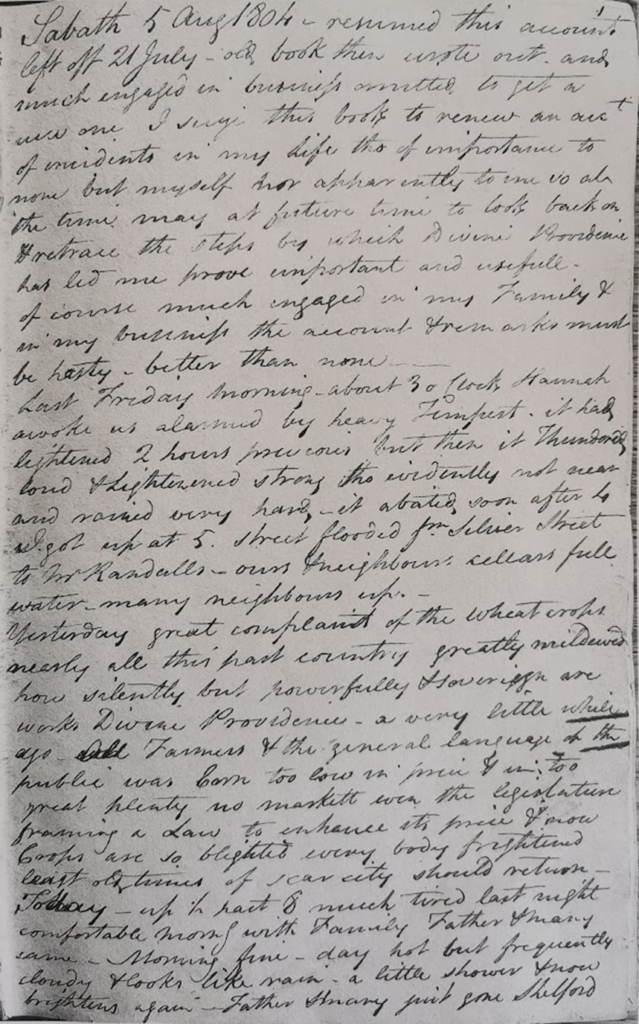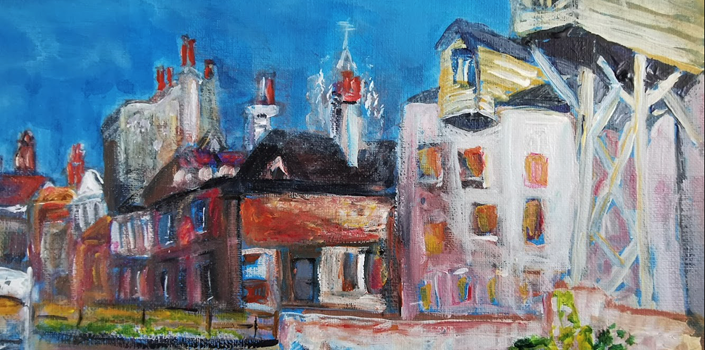King’s and Bishop’s Mill, Mill Lane, Cambridge (acrylic painting, 2024, after an early 20th century watercolour)
James Nutter (1763-1829) was the first of a number of generations of Cambridge millers in which the first born were all called James Nutter. This James Nutter was owner and manager of the Bishop’s Mill (freehold) and the King’s Mill (leased from the corporation of Cambridge) that used to sit at the end of Mill Lane over the river where the little pedestrian bridge now stands, the sole remaining witness to the mills that were demolished in 1928. Today the area around the mill pond has become a place for students and tourists to relax and sit for a picnic or a drink. Before 1928 the place was one of intense work. James’ workmen could be seen hoisting bags of wheat from barges on the river up to the wooden granaries of the mills.
The two wheels of the mill that sat side by side were entirely powered by the flowing water of the Cam. James Nutter was therefore constantly and anxiously recording rainfall levels and wind activity in his diary. The front page of this diary is shown here for the first time courtesy of his family.
Periods of drought or frost regularly hindered the work of the mills through the year, not only preventing the wheels from turning, but also affecting the transport of grain by barges on the river. It is therefore not surprising that James’ diary contains detailed recordings of weather patterns, well before systematic recordings by the Meteorological Office started.

The entry for the 5th August 1804 (see photo) shows that Silver Street and the cellars nearby were flooded after a heavy “tempest.” The weather was so damp that the wheat crop was mildewed, triggering fears of scarcity and famine. The diary covers the period between 5 August 1804 and 4 February 1806, a time marked by bad harvests and uncertainty caused by the long Napoleonic wars.
James would have been happy for his diary to be read by later generations. A very well educated man, he understood the importance of recording events so that one can “at a future time, look back and retrace the steps” by which “Divine Providence” had led him to be “useful” (his own words). There is no doubt that James Nutter was a useful citizen of Cambridge as his mills provided the local population with the flour they so needed in a time of war to make bread, the staple diet at the time. “Verily thou should be fed” James writes in his entry of 13th October 1804. He, indeed, made sure that this was true by importing wheat from as far away as Germany (via the port of King’s Lynn) when there was not enough wheat produced locally to grind at his mills. The diary is an important witness to the globalisation of the wheat market in the early 19th century when the sudden growth of the population could not be matched by local agricultural production.
James’ diary covers many themes that strongly resonate today: wheat and flour shortage, unpredictable weather patterns, long and destructive wars. The diary also offers a valuable testimony to the ups and downs of the renewable energy source, the Cam, that powered the watermills of Cambridge and supplied the flour needed to feed the local population.
For more information about the King’s and Bishop’s Mills see:
